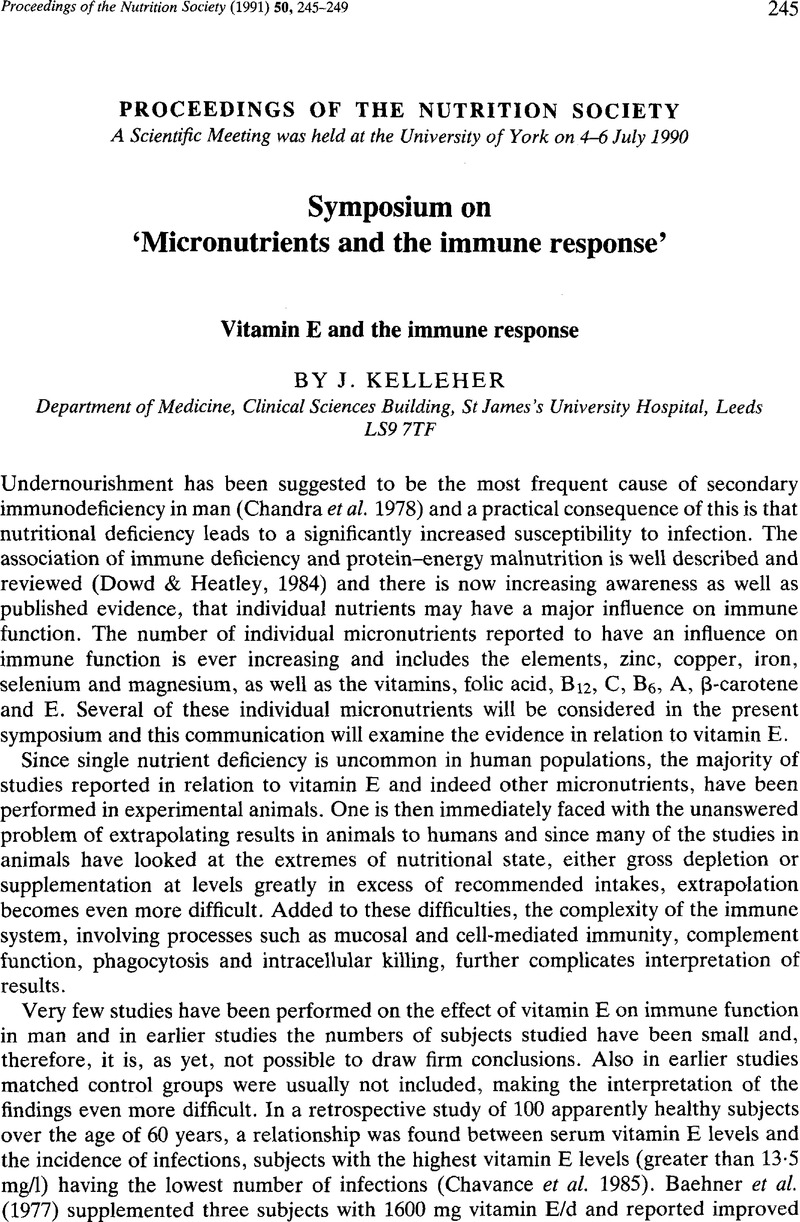Crossref Citations
This article has been cited by the following publications. This list is generated based on data provided by Crossref.
Shrimpton, D. H.
1993.
The Technology of Vitamins in Food.
p.
42.
Fitzpatrick, E. A.
Rhoads, C. A.
Espandiari, P.
Kaplan, A. M.
and
Cohen, D. A.
1995.
Ethanol as a Possible Cofactor in the Development of Murine AIDS.
Alcoholism: Clinical and Experimental Research,
Vol. 19,
Issue. 4,
p.
915.
Losonczy, KG
Harris, TB
and
Havlik, RJ
1996.
Vitamin E and vitamin C supplement use and risk of all-cause and coronary heart disease mortality in older persons: the Established Populations for Epidemiologic Studies of the Elderly.
The American Journal of Clinical Nutrition,
Vol. 64,
Issue. 2,
p.
190.
Harbige, Laurence S.
1996.
Nutrition and Immunity with Emphasis on Infection and Autoimmune Disease.
Nutrition and Health,
Vol. 10,
Issue. 4,
p.
285.
Kutukculer, Necil
Akil, Talha
Egemen, Ayten
Kurugöl, Zafer
Akşit, Sadık
Özmen, Dilek
Turgan, Nevbahar
Bayındır, Oya
and
Çağlayan, Suat
2000.
Adequate immune response to tetanus toxoid and failure of vitamin A and E supplementation to enhance antibody response in healthy children.
Vaccine,
Vol. 18,
Issue. 26,
p.
2979.
Masaki, K.H.
Losonczy, K.G.
Izmirlian, G.
Foley, D.J.
Ross, G.W.
Petrovitch, H.
Havlik, R.
and
White, L.R.
2000.
Association of vitamin E and C supplement use with cognitive function and dementia in elderly men.
Neurology,
Vol. 54,
Issue. 6,
p.
1265.
Feki, Moncef
Souissi, Malek
Mokhtar, Elyes
Hsairi, Mohamed
Kaabachi, Naziha
Antebi, Helena
Alcindor, Louis Gérald
Mechmeche, Rachid
and
Mebazaa, Abderraouf
2000.
Vitamin E and Coronary Heart Disease in Tunisians.
Clinical Chemistry,
Vol. 46,
Issue. 9,
p.
1401.
Panousis, N.
Karatzias, H.
Roubies, N.
Papasteriadis, A.
and
Frydas, S.
2001.
Effect of selenium and vitamin E on antibody production by dairy cows vaccinated againstEscherichia coli.
Veterinary Record,
Vol. 149,
Issue. 21,
p.
643.
Harbige, Laurence S.
and
Gershwin, M. Eric
2004.
Handbook of Nutrition and Immunity.
p.
187.
Fekete, S.Gy.
and
Kellems, R.O.
2007.
Interrelationship of feeding with immunity and parasitic infection: a review.
Veterinární medicína,
Vol. 52,
Issue. 4,
p.
131.
OTOMARU, Konosuke
SAITO, Shun
ENDO, Karura
KOHIRUIMAKI, Masayuki
FUKUYAMA, Shin-ichi
and
OHTSUKA, Hiromichi
2013.
Effect of Supplemental Vitamin E on Antibody Titer in Japanese Black Calves Vaccinated against Bovine Herpesvirus-1.
Journal of Veterinary Medical Science,
Vol. 75,
Issue. 12,
p.
1671.
Murray, Michael T.
2013.
Textbook of Natural Medicine.
p.
516.
O'Brien, Teresa
Thomas, David G.
Morel, Patrick C.H.
and
Rutherfurd-Markwick, Kay J.
2015.
Moderate dietary supplementation with vitamin E enhances lymphocyte functionality in the adult cat.
Research in Veterinary Science,
Vol. 99,
Issue. ,
p.
63.
Pourafshar, Shirin
Johnson, Sarah A.
Keshavarz, Behnam
Feresin, Rafaela G.
Khalil, Dania A.
Chai, Sheau C.
and
Arjmandi, Bahram H.
2018.
The effects of supplemental vitamin E on hematological parameters in a rat model of ovarian hormone deficiency.
Menopause,
Vol. 25,
Issue. 3,
p.
336.
Murray, Michael T.
and
Nowicki, John
2020.
Textbook of Natural Medicine.
p.
1009.
Zhang, Tianyi
Yi, Xianyanling
Li, Jin
Zheng, Xiaonan
Xu, Hang
Liao, Dazhou
and
Ai, Jianzhong
2023.
Vitamin E intake and multiple health outcomes: an umbrella review.
Frontiers in Public Health,
Vol. 11,
Issue. ,



